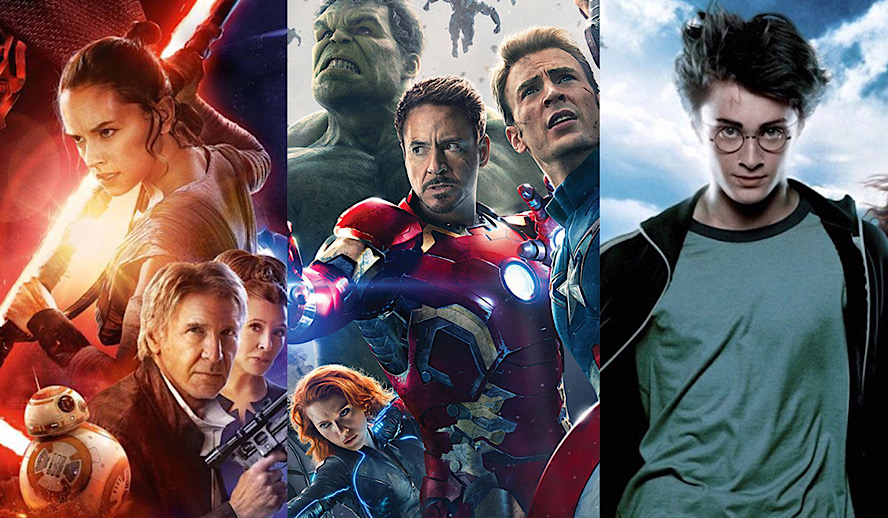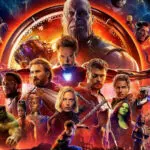Table of Contents

Video Version of this Article
Photo/Video: Movie Franchise/Hollywood Insider YouTube Channel
The Modern Film Landscape
It is no secret that Hollywood loves sequels. It is simple math, more than one film offers more profits. Over time, a ‘part two’ was no longer what studios were striving for; they wanted more. The prospect of a franchise has always been attractive — this has never been a secret. However, there has been an even greater pursuit as of late to create franchises — the primary motivation for this: the Marvel Cinematic Universe. Kevin Fiege and the team at Marvel Studios changed the game with their unprecedented twenty-three movie run of profitability and cultural-sensation after launching with Jon Favreau’s ‘Iron Man’ in 2008. Not unlike any other industry, the success seen by Marvel bred attempts at imitation.
Related article: Marvel Cinematic Universe: 32 Marvel Movies Facts From ‘Iron Man’ to ‘Avengers’ in the MCU
Related article: Star Wars Facts: 32 Things You Didn’t Know About the Most Famous Franchise
The History of the Movie Franchise
The MCU did not invent the franchise, though some may say they perfected it. Before the success of the MCU, some of the first franchises began with horror films — ‘Halloween’, ‘Friday the 13th’, and ‘A Nightmare on Elm Street’ all launched franchises of their own but unfortunately, all three eventually dipped below the standards of their original film. Though critically, many of the horror franchise sequels did not live up to the expectations of their original, financially they stayed somewhat viable which potentially led to the lack of innovation in the filmmaking.
The iconic spy-thriller series, The James Bond Franchise, had also been putting out films for forty-plus years at the point that the MCU gained its footing. ‘Star Wars’ had its run under the guidance of George Lucas, but as two connected trilogies instead of a continued saga. The concept of the franchise has been attempted at nausea with a wide range of outcomes — to fully understand how to craft a successful franchise, one must familiarize themselves with that wide array of outcomes.
Subscribe to Hollywood Insider’s YouTube Channel, by clicking here.
The Marvel Cinematic Universe
The Marvel Cinematic Universe is inarguably the most successful film franchise of all time. Every film of the MCU has been profitable, many passing a billion dollars at the worldwide box-office, and all have garnered a fresh percentage on the Rotten Tomatoes Tomatometer. The genius of the MCU is in its structure and writing. Structurally, the Marvel Cinematic Universe was patient, taking a decade to reach its climax in 2019’s ‘Avenger’s: Endgame’. This patience was rewarded with the climactic finale eventually becoming the highest-grossing film of all time. Before creating the first big-budget team-up superhero film in 2012’s ‘Marvel’s The Avengers’, Marvel Studios took the time to give almost all its main cast of Avengers solo films before its team-up. This allowed audiences to become endeared to the characters before entering the theater to see them all working together.
Audiences were allowed to enjoy the action-packed blockbuster for the spectacle it was rather than having to actively learn and get accustomed to the main characters. A franchise that took a different approach was the DC Extended Universe — ahead of their title team-up film, only Superman and Wonder Woman had received their own movies putting them at a disadvantage in the minds of audiences who were not already emotionally attached to some of these iterations of the characters. It also puts the writers at a disadvantage, instead of them just having to give exposition about the plot of their team-up film, they also had to give character exposition of most of their main characters. Amongst other production issues, ‘Justice League’ went on to drastically underperform the success of Marvel’s ‘The Avengers’ and even the expectations of the studio.
Related article: The Power of Positivity: Ikorodu Bois + Chris Hemsworth + Russo Brothers + Sam Hargrave
Limited Time Offer – FREE Subscription to Hollywood Insider
The screenwriters also had a major hand in the success of the MCU; every Marvel film feels both fresh and fits within the universe. The likable characters, exceptional visuals, and witty banter keep all the films feeling similar and the subversion of subgenres the writers implement has them feeling fresh and new. Superhero movies have mostly similar story beats, what the writers at Marvel have done to avoid this feeling of repetition is genre-splicing two subgenres. For example, Peyton Reed’s ‘Ant-Man’ has the feeling and plot points of a Marvel superhero origin story while also having the story beats of a heist film. This clever screenwriting trick is utilized throughout the MCU keeping all their films feeling fresh.
The writers also made sure to interlink the films, attaching bits of information that weave through and intertwine plot points across the series — this tactic helps engage audiences as each film, while its own complete story, builds upon the other making viewers want to go out and see the next one. The cliffhanger ending of ‘Avengers: Infinity War’ had fans so interested in what came next that it helped its follow-up, ‘Avengers: Endgame’, enjoy even greater success. The Marvel Cinematic Universe is the gold standard for how to structure and craft your franchise and studios will attempt to replicate its success for years to come.
Related article: Hollywood Insider’s CEO Pritan Ambroase: “The Importance of Venice Film Festival as the Protector of Cinema”
Related article: The Masters of Cinema Archives: Hollywood Insider Pays Tribute to ‘La Vie En Rose’, Exclusive Interview with Director Olivier Dahan
‘Harry Potter’
Based on the hit series of novels written by J.K. Rowling, ‘Harry Potter and the Sorcerer’s Stone’ launched an eight-film franchise that was a model of consistency and a masterclass in adaptation. The director of ‘Home Alone’, Chris Columbus, helmed the first two films. The family-friendly movies received a positive response both critically and financially. In preparing for the third film, ‘Harry Potter and the Prisoner of Azkaban’, Warner Brothers opted for a director change in the form of Alfonso Courón. Similarly to the MCU, the third film in the franchise still had the magic of a Harry Potter film but was stylistically unique from the previous two films. ‘Harry Potter and the Prisoner of Azkaban’ was noticeably darker in tone and aesthetic — the fade-in is utilized more than any other Potter film.
The fourth film, ‘Harry Potter and the Goblet of Fire’, again switched up the director’s chair with Mike Newell getting the nod. Still maintaining the darker tone introduced by Courón, Newell brought his own stylistic flair to the film. David Yates did the same with his quick-cut editing and discontinuity montages in ‘Harry Potter and the Order of the Phoenix’. Yates would go on to finish out the remainder of the films through the series’ conclusion, ‘Harry Potter and the Deathly Hallows Part 2’.
The Harry Potter franchise is an example of how to lay out a franchise well. While there was not much creative wiggle room story-wise, the studio knew when it was time to switch up directors and when to let them finish their story. They perfectly balanced patience and self-awareness. The only issue structurally, is the dividing of the final novel into two parts. While financially a successful move, the final two films felt like two halves of a story. As the first half of a story, ‘Harry Potter and the Deathly Hallows Part 1’ felt like the build-up, an act I — this left ‘Harry Potter and the Deathly Hallows Part 2’ feeling a non-stop, third-act climax. When watched together, they work; unfortunately separate, part one feels incomplete.
Related article: All 8 Harry Potter Movies, Ranked – Did Your Favourites Make the List?
Related article: A Retrospective On ‘Mission: Impossible’ – One of the Most Durable Film Franchises
‘Star Wars’
In 1977, George Lucas changed the landscape of cinema with his fantasy space-opera, ‘Star Wars’. Decades later, the ‘Star Wars’ brand is as strong as ever after Disney acquired Lucasfilm. The ‘Star Wars’ franchise is more or less three distinct trilogies — the first three films, commonly known as the Original Trilogy, were directed by three different directors. ‘Star Wars’ was directed by George Lucas, its sequel, ‘The Empire Strikes Back’, was directed by Irvin Kershner, and the finale, ‘Return of the Jedi’, was helmed by Richard Marquand. While the first three films were directed by three different filmmakers, George Lucas oversaw the story of all three films, acting as a guide and the overall vision of the trilogy.
This carried over into the Prequel Trilogy, the only difference: George Lucas would now also direct all three films. While the Prequel Trilogy performed at the box office and over time has aged well in the hearts of Star Wars fans, they released to harsh critics of Lucas’s direction, writing, and over-use of visual effects leading to the eventual sale to Disney. The Disney-produced trilogy of ‘Star Wars’ films, now known as the Sequel Trilogy, were met with a divisive reaction by audiences and subsequent diminishing returns at the box office. Disney decided to attach their directors ahead of the production of the films, landing on J.J. Abrams of ‘Lost’ and ‘Star Trek’ fame, Rian Johnson writer and director of ‘Brick’ and ‘Looper’, and Colin Trevorrow of ‘Safety Not Guaranteed’ and ‘Jurassic World’. All three directors were proven comedies of both smaller indie films and big-budget blockbusters.
Related article: The Future of Star Wars: Where Will the Iconic Franchise Lead Us to Next?
Related article: Unfinished Film Franchises: Stories in Film Left Incomplete With Abandoned Story Arcs
The first of the trilogy, ‘Star Wars: The Force Awakens’ directed by Abrams, released to praise by critics and fans alike — the film eventually going on to become the third highest-grossing film of all time. The follow-up to Abram’s success, Johnson’s ‘Star Wars: The Last Jedi’, released to a more divided base. While critics praised Johnson for his risk-taking, fans criticized its overall fit in both this trilogy and the overall ‘Star Wars’ saga. Regardless if one liked the film or not, most would agree that it felt like a departure. In pre-production of the final installment in the Sequel Trilogy, Colin Trevorrow exited the project citing creative differences and Abrams was brought back on to direct the final film.
‘Star Wars: The Rise of Skywalker’ had a lukewarm response on all fronts, underperforming critically, financially, and with the fans — some saw it as trying to appease the criticism of ‘Star Wars: The Last Jedi’ rather than trying to be its own film and compelling conclusion to the Sequel Trilogy. Disney has had success diversifying Star Wars with spin-off films and television shows, such as ‘The Mandalorian’, that have garnered successful followings with Lucasfilm allowing filmmakers to tell their own Star Wars stories. Looking retrospectively at the Sequel Trilogy, Lucasfilm should be praised for giving their filmmakers the creative freedom to take risks, but lacking the vision that the Original and Prequel Trilogies had in their story proved to be problematic.
Related article: Dino DNA: How the ‘Jurassic Park’ Series/Franchise Has Innovated Itself Beyond Extinction
Related article: James Bond Books and Movies: The Evolution of our Favourite Spy Since Ian Fleming
‘Transformers’
The ‘Transformers’ Franchise has been a controversial one amongst fans of Cinema since Michael Bay released the first installment of his five-film series, ‘Transformers’, in 2007. Financially, all five entries have done exceptionally at the box office, especially internationally, yet critically have not been met with much love. Regardless of one’s opinion of the film’s quality, it is inarguable that there is a formula that the films follow — a sort of checklist each film ticks boxes off of. The films commonly have a group of main human characters, big action set pieces, a military subplot, and an enormity of visual effects.
While financially this sells, there is something to be said that after five films of similar content helmed by the same director that a spin-off would have the most positive critical reception of the franchise. ‘Bumblebee’, a spin-off film focusing on the title character, directed by Travis Knight, was the first deviation from the one-director model the franchise had previously been committed to. It is significant that ‘Bumblebee’ garnered the highest critical praise of any of the ‘Transformers’ movies even if it didn’t exceed box-office expectations.
Related article: The Complete List of 2021 Oscar Nominations – Celebrations, Surprises & Snubs | The Show Must Go On
Related article: April Movies Release Schedule: The Most Accurate List of Every Movie Coming Out in April – Live Updates
The Lessons Learned
There have been many successful franchises, but the reasoning as to why one is successful and why another isn’t varies — the definition as to what success means to a franchise also is case by case. Whether a franchise looks to succeed financially, critically, or with its die-hard fans, there are lessons to be learned from the past to position one’s franchise for their preferred kind of success. The most crucial element of the success of a franchise is to have a vision of where it will go. Every franchise that has succeeded had a plan, it had someone who was overseeing where the story would go — whether that be a producer in Kevin Feige, your source material’s writer in J.K. Rowling, or the creator of your original film in George Lucas, a franchise needs someone at the helm of the story.
Once you’ve established that, you must diversify your directing slate — the films need to feel fresh while also having audiences and fans feeling at home. Having someone at the head of story oversight aids the director selection process as that individual can recommend or select directors that fit the overall vision of the franchise. Crafting a franchise is not unlike crafting a film, just on a larger scale. The filmmakers need to know the beginning, the middle, and the end before they make the movie. There are always exceptions to the rule, but the best way to mitigate risk and position a franchise for success is by having a vision of the story you want to tell and how to tell it.
By Sean Aversa
Click here to read Hollywood Insider’s CEO Pritan Ambroase’s love letter to Black Lives Matter, in which he tackles more than just police reform, press freedom and more – click here.
An excerpt from the love letter: Hollywood Insider’s CEO/editor-in-chief Pritan Ambroase affirms, “Hollywood Insider fully supports the much-needed Black Lives Matter movement. We are actively, physically and digitally a part of this global movement. We will continue reporting on this major issue of police brutality and legal murders of Black people to hold the system accountable. We will continue reporting on this major issue with kindness and respect to all Black people, as each and every one of them are seen and heard. Just a reminder, that the Black Lives Matter movement is about more than just police brutality and extends into banking, housing, education, medical, infrastructure, etc. We have the space and time for all your stories. We believe in peaceful/non-violent protests and I would like to request the rest of media to focus on 95% of the protests that are peaceful and working effectively with positive changes happening daily. Media has a responsibility to better the world and Hollywood Insider will continue to do so.”
Ways to support Black Lives Matter Movement to end systemic racism
More Interesting Stories From Hollywood Insider
– Want GUARANTEED SUCCESS? Remove these ten words from your vocabulary| Transform your life INSTANTLY
– Compilation: All James Bond 007 Opening Sequences From 1962 Sean Connery to Daniel Craig
– Do you know the hidden messages in ‘Call Me By Your Name’? Find out behind the scenes facts in the full commentary and In-depth analysis of the cinematic masterpiece
– A Tribute To The Academy Awards: All Best Actor/Actress Speeches From The Beginning Of Oscars 1929-2019 | From Rami Malek, Leonardo DiCaprio To Denzel Washington, Halle Berry & Beyond | From Olivia Colman, Meryl Streep To Bette Davis & Beyond
– In the 32nd Year Of His Career, Keanu Reeves’ Face Continues To Reign After Launching Movies Earning Over $4.3 Billion In Total – “John Wick”, “Toy Story 4”, “Matrix”, And Many More
movie franchise, movie franchise, movie franchise, movie franchise, movie franchise, movie franchise, movie franchise, movie franchise, movie franchise, movie franchise, movie franchise, movie franchise, movie franchise, movie franchise, movie franchise, movie franchise, movie franchise, movie franchise, movie franchise, movie franchise, movie franchise, movie franchise, movie franchise, movie franchise, movie franchise, movie franchise, movie franchise, movie franchise, movie franchise, movie franchise, movie franchise, movie franchise, movie franchise, movie franchise, movie franchise, movie franchise, movie franchise, movie franchise, movie franchise, movie franchise, movie franchise, movie franchise

Sean Aversa is a writer for Hollywood Insider, writing film reviews and features. Knowing from a very early age his passion for the big screen, Sean quickly gravitated towards film writing. He is excited for the opportunity to write about films and filmmakers that share his passion for cinematic storytelling. His favorite films to watch, discuss, and write about are those that are striving to find creative and innovative ways to tell stories.








